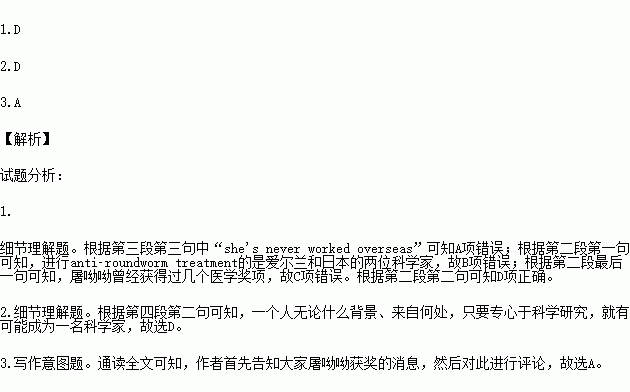题目内容
阅读理解。
Chinese female scientist Tu Youyou won the 2015 Nobel Prize in medicine on October 5 for her discoveries concerning a novel treatment against malaria (疟疾). This is the first Nobel Prize given to a Chinese scientist for work carried out within China.
Tu shared the prize with Irish?born William Campbell and Satoshi Omura of Japan, who were honored for their revolutionary anti?roundworm treatment. 84?year?old Tu is awarded this prize for her contribution to cutting the death rate of malaria, reducing patients' suffering and promoting mankind's health. Although she received several medical awards in the past, the 2015 Nobel Prize is definitely the most privilege reward that recognizes Tu's dedication and perseverance in discovering artemisinin (青蒿素), the key drug that battles malaria?friendly parasites (寄生虫).
However, her route to the honor has been anything but traditional. She won the Nobel Prize for medicine, but she doesn't have a medical degree or a PhD. In China, she is even being called the “three?noes” winner: no medical degree, no doctorate, and she's never worked overseas. No wonder her success has stirred China's national pride and helped promote confidence of native Chinese scientists.
The fact that Tu has none of these three backgrounds reminds us that science should be more accessible to all. One shall be able to become a scientist no matter what kind of background he or she comes from, as long as one dives into scientific research. There have been discussions on people who really love science but are never able to achieve much during their whole life. Their contributions can never be ignored. They work so hard to prove the wrong way so that the future researchers will be closer to the right one.
As the first Chinese mainland Nobel Prize Winner of natural science award, Tu's record?breaking winning also serves as a reminder to those who are too eager for instant success. Science is never about instant success. Tu spent decades on scientific research before its value is officially acknowledged. There is no way to measure how much one devotes to science and compare it with how much reward he or she may get.
1.We can know from the text that ________.
A.Tu worked at home and abroad to conduct her research
B.Tu got the Nobel Prize for her anti?roundworm treatment
C.the Nobel Prize is the first award to recognize her work
D.her discovery of artemisinin has helped to cut malaria death rate
2.The author seems to agree that a person who is more likely to become a scientist is the one with________.
A.a sense of national pride
B.relevant academic knowledge
C.a desire to achieve success
D.enthusiasm for scientific research
3.In writing the passage, the author intends to________.
A.inform readers of the news and make comments
B.discourage the pursuit of instant success in science
C.remind readers of the principles of scientific research
D.praise the award winner and encourage scientific research



